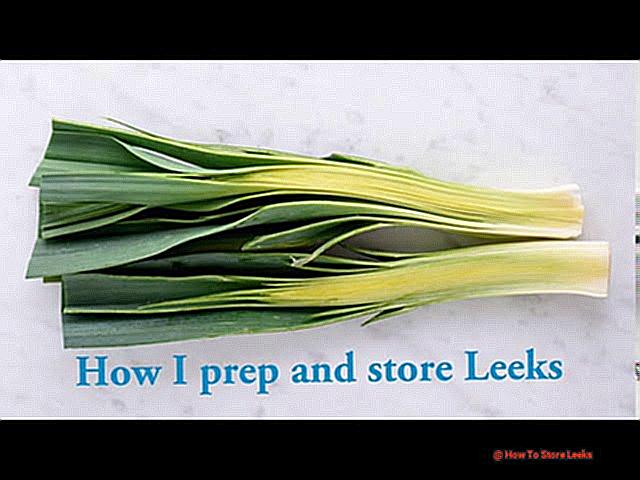Do you find yourself constantly throwing out wilted leeks and wasting money? Are you tired of struggling to keep these versatile veggies fresh for your next recipe? Look no further, because in this blog post, we’re sharing our top tips for storing leeks like a pro. Say goodbye to wasted produce and hello to perfectly preserved leeks with these simple yet effective techniques.
First things first, always trim the roots and dark green tops before storing your leeks. This not only helps them fit better in your fridge but also prevents any excess moisture from causing them to spoil.
Next, consider the best storage methods. For short-term storage, place your trimmed leeks in the crisper drawer of your refrigerator or wrap them in damp paper towels before placing them in a plastic bag. This will help maintain their moisture and freshness.
It’s also important to keep in mind what not to store with your leeks. Avoid placing them near ethylene-producing fruits like apples or bananas, as this can cause them to ripen and spoil faster.
But what about long-term storage? If you want to freeze your leeks for later use, simply chop them up and place them in an airtight container or freezer bag. They’ll stay fresh for months.
Lastly, remember that fresher is better when it comes to leeks. Aim to use them within 3-4 days for optimal flavor and texture.

With these tips in mind, you’ll never have to toss out unused leeks again. So let’s get started on learning how to properly store these delicious vegetables for all your future culinary adventures.
Contents
Harvesting leeks – tips and tricks
Leeks are a flexible and mouth-watering vegetable that can be harvested and preserved in various ways to guarantee freshness and safety for consumption. Here are some useful pointers for harvesting and storing leeks:
Harvesting Tips:
- Leeks should be collected when they reach approximately one inch in diameter, as this ensures the best taste and texture.
- Gently loosen the soil around the leeks and carefully pull them out, being mindful not to harm the roots.
- Brush off any excess soil and thoroughly rinse the leeks to eliminate any grit.
Storing Tips:
- The ideal method for storing leeks is in the refrigerator, where they can last up to two weeks.
- Wrap the leeks in a moist paper towel and seal them in a plastic bag before placing them in the fridge.
- Alternatively, you can store leeks in your garden by hilling up soil around them and covering them with mulch to protect against frost.
Extended Storage Tips:
- Despite popular belief, leeks can actually be preserved for months with the right technique.
- They are resistant to frost and can be left in the ground if winters are mild enough, but it is safest to store them in containers filled with sand or garden soil in a cool room.
- The recommended temperature for storage is between 32-40°F (0-4°C).
- To prepare leeks for extended storage, trim them but leave as much of the plant as possible.
- Pack them upright in containers filled with 5-7 inches of sand or soil, ensuring they do not touch each other.
- Keep the containers in a cool, dark, and well-ventilated space such as a root cellar or basement.
- When properly stored, leeks can maintain their flavor and texture for up to 3 months.
In conclusion, harvesting leeks at the appropriate time and storing them correctly is vital for maintaining their freshness and safety.
Processing leeks for storage
When it comes to storing leeks, proper harvesting and cleaning techniques are crucial, as well as choosing the right storage method. Here are some top tips for processing and storing leeks:
- Harvesting: Leeks can be picked at any time they reach a desirable size, typically around 1 inch in diameter. However, if you want sweeter and more tender leeks, wait until after the first frost to harvest them. When harvesting, gently pull the plant out of the ground to avoid breaking the stem and leaving the root behind.
- Cleaning: After picking, make sure to clean the leeks by trimming off any damaged or dirty outer leaves. Rinse them under cold water to remove any remaining dirt or debris.
- Preparation: To ensure optimal storage, prepare leeks by trimming the roots and cutting off any dark green parts of the leaves, leaving only the white and light green parts intact.
- Storage method: For longer storage periods, leeks can be stored in containers filled with garden soil or wrapped in damp paper towels and placed in a plastic bag in the fridge. Garden soil is a better option than sand as it provides continued growth and nutrients.
- Storage conditions: To maintain freshness, store leeks in a cool, dark, and well-ventilated space such as a root cellar or basement. They can be safely stored for up to 3 months under these conditions.
Here is a table summarizing the best methods for processing and storing leeks:
| Harvesting | Clean and gently pull out of ground | Anytime after reaching desired size |
| Cleaning | Remove damaged/dirty leaves and rinse under cold water | After picking |
| Preparation | Trim roots and remove dark green parts of leaves | Before storage |
| Storage method | Containers with garden soil or wrapped in damp paper towels in plastic bag in fridge | |
| Storage conditions | Cool, dark, and well-ventilated space (root cellar or basement) | Up to 3 months |
By following these methods for processing and storing leeks, you can ensure they remain fresh and safe to eat for an extended period of time. While properly stored leeks may not have the same texture as freshly harvested ones, they will still be delicious and safe to consume.
Storing leeks in sand or garden soil
Preserving the freshness and flavor of leeks, a versatile vegetable, can be done effectively by storing them in sand or garden soil. This method, which offers numerous benefits, is a great way to ensure that you have a continuous supply of produce during the colder months. Here’s a closer look at the advantages and steps to successfully store leeks in sand or garden soil:
- Longer Storage Time: One of the most significant benefits of storing leeks in sand or garden soil is the extended storage time it provides. By using this method, leeks can last fresh for up to 3 months in the garden, making it an ideal option for those with limited storage space.
- Cold Tolerance: Winter varieties of leeks are known for their ability to tolerate cold temperatures as low as 10°F without spoiling or freezing. This makes them an excellent option for storing in sand or garden soil, providing you with fresh leeks all winter long.
- Root Cellar Option: Another option for preserving leeks is storing them in wet sand in a root cellar. The moist sand will keep the leeks hydrated, while the cool temperature of the cellar will maintain their freshness.
- Dehydration: For long-term storage, leeks can also be dehydrated. This involves thinly slicing them and drying them in a dehydrator until fully dried. Once dried, they can be stored in an airtight container for up to 1 year.
- Freezing: Freezing is another method for long-term storage of leeks. To do this, slice the leeks and place them on a cookie sheet before transferring them to a freezer-safe container. This allows for easy portioning and use when needed.
Here is a table summarizing the different methods of storing leeks:
| Method | Storage Time | Benefits |
| Garden | Up to 3 months | Continuous supply during winter months |
| Root Cellar | Up to 3 months | Moist sand keeps leeks hydrated and cool temperature maintains freshness |
| Dehydration | Up to 1 year | Preserves leeks for longer storage period |
| Freezing | Up to 1 year | Easy portioning and use when needed |
Storing leeks in sand or garden soil is an excellent way to keep them fresh and flavorful for extended periods. Whether you have a root cellar or limited storage space, there are various methods to choose from based on your needs.
How well do leeks keep long-term?
Leeks are a versatile and nourishing vegetable that can add flavor and complexity to many dishes. However, their long green stalks and delicate texture may raise doubts about their storage and shelf life. Thankfully, there are numerous effective strategies for storing leeks to guarantee their long-term freshness. These methods involve refrigeration, freezing, and storing in sand or garden soil.
Refrigeration is the most common approach for storing leeks. To do this, simply wrap unwashed and untrimmed leeks loosely in plastic or a plastic bag and place them in the fridge. If you plan on using them within 2-3 days, leaving them at room temperature is also acceptable. However, for longer storage periods, it is best to keep them in the fridge.
Another efficient method for storing leeks is by placing them in sand or garden soil. This replicates the conditions of a root cellar and can provide cold tolerance for up to 1 year. Simply put the leeks in a container filled with damp sand or soil, ensuring that the roots are covered. Store the container in a cool and dark place, such as a basement or cellar.
Dehydration is another popular method for preserving leeks. To dehydrate leeks, cut them into thin rings and lay them on a baking sheet lined with parchment paper. Place the sheet in an oven set to the lowest temperature (around 140-150°F) until the leeks are completely dry. Once dried, store them in an airtight container in a cool and dark place.
Lastly, leeks can also be frozen for longer storage periods. To do this, blanch the leeks (boil them for 2 minutes) before draining and cooling them in ice water. Then, pat dry and place in a freezer-safe container or bag before placing them in the freezer. Frozen leeks can last up to 12 months.
Conclusion
To ensure the lasting freshness and flavor of your leeks, proper storage is crucial.
With our expert tips, you can bid farewell to wasted produce and welcome perfectly preserved leeks into your kitchen. Remember to trim the roots and dark green tops before storing, choose a suitable storage method for your needs, and keep them away from ethylene-producing fruits.
By utilizing these techniques, you can savor delicious leeks all year long.




